 |
 |
 |
| |
Overview of Drug Interactions Between Brecanavir (BCV) and Other HIV Protease Inhibitors (PIs)
|
| |
| |
Reported by Jules Levin
XVI Intl AIDS Conference, Toronto, Aug 2006
M Shelton, S Ford, M Anderson,
S Murray, J Ng-Cashin
XVI International AIDS Conference, Toronto, Canada,
August 2006
Author's Conclusions
- BCV may be co-administered with LPV/r without dose adjustment
- For BCV/r + ATV, plasma exposure to both BCV and ATV increased. Clinical significance unknown, but ATV dose reduction may be considered.
- BCV should not be co-administered with TPV/r due to reduced plasma BCV trough concentrations: Potential for increased hepatic transaminases in patients
- RTV 200mg does not significantly increase steady-state plasma BCV exposure
- Dual boosted PI options for BCV include LPV/r and ATV
640385 (Brecanavir*, BCV)
- Potent new protease inhibitor
- Median IC50 in PBMCs = 0.03 nM: Range (0.02-0.10 nM)
- Substrate for CYP450 3A4 and p-gp
- Bioavailability significantly increased with RTV 100mg and meals
- No significant pharmacokinetic interaction with TFV, ZDV or 3TC
- Generally well tolerated
- Currently in Phase II development
BCV Clinical Development Strategy
Resistance profile suggests BCV could be highly effective for treatment-experienced HIV patients
For this population, dual RTV boosted PIs have been evaluated, but robust clinical data is sparse
Negative interactions have been observed for dual RTV boosted PI regimens
-- Tipranavir (TPV): lowered exposure other PI
-- APV/Kaletra: lowered exposure to both PIs
PI interaction studies in healthy subjects
-- First drug interactions with CYP substrates
3 separate studies were planned:
-- 1st Lopinavir/ritonavir (LPV/r) - HPR10004*
-- 2nd Atazanavir (ATV) - HPR10009*
-- 3rd Tipranavir (TPV) - HPR103377
* Ford S, et al. 7th International Workshop on Clinical Pharmacology of HIV Therapy, Lisbon, Portugal, 20 - 22 April, 2006 (posters 51 and 76)
BCV PI Drug Interaction Studies
Different strategies:
LPV/r and ATV - hypothesis testing
-- evaluate combination relative to boosted PI
TPV - estimation approach
-- confirm anticipated TPV effects on BCV PK
-- evaluate higher RTV dose (200mg)
Different BCV doses (during dose ranging):
-- LPV/r and ATV - BCV 300mg /RTV 100mg BID
-- TPV - BCV 600mg /RTV 100mg BID
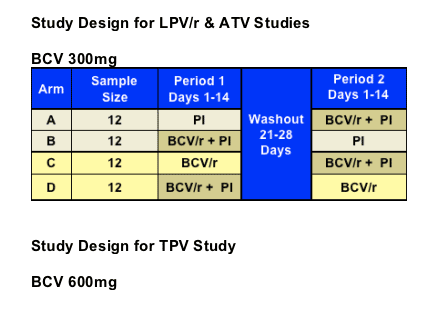
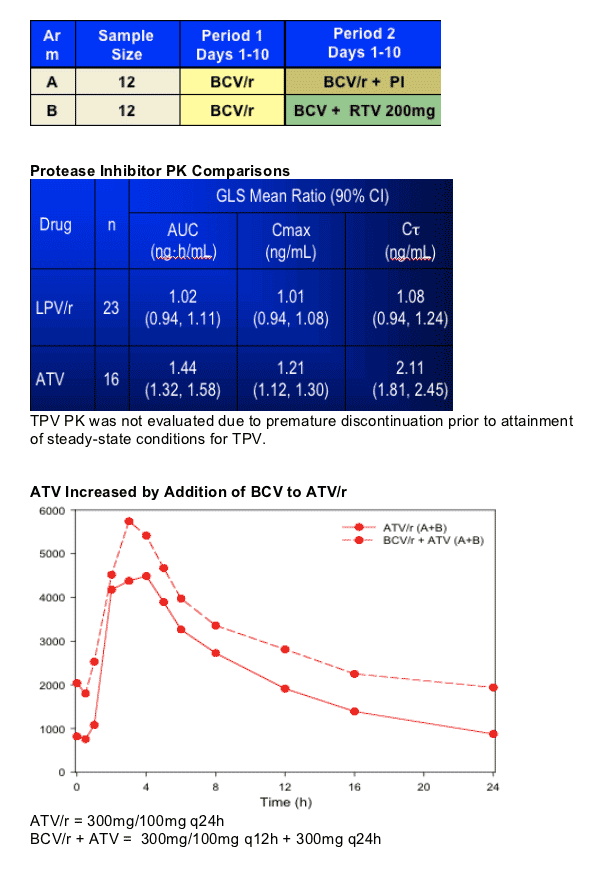
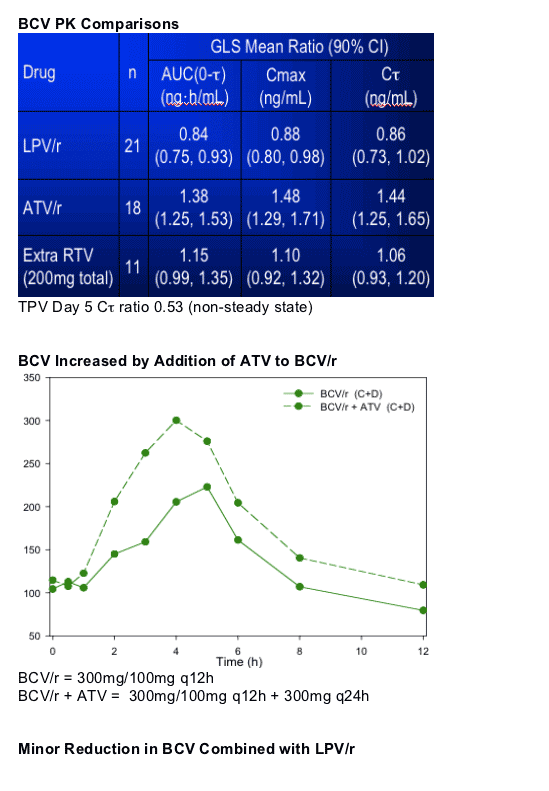
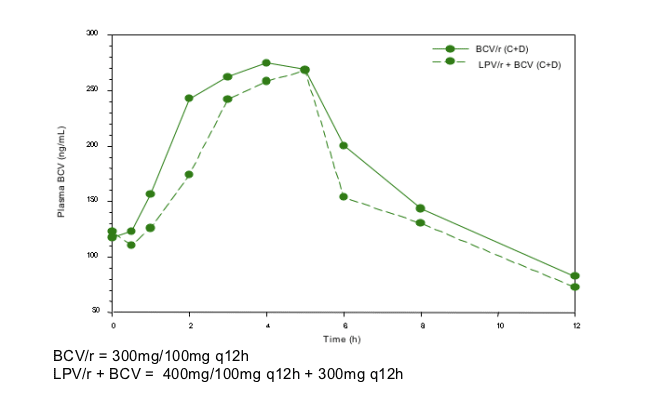
Hepatic Transaminases in TPV Study
BCV 600mg + RTV 200mg + TPV 500mg q12h
7/12 subjects had increased ALT.
Maximum DAIDS Toxicity Criteria:
-- Grade 1 (N=3), Grade 2 (N=2), Grade 3 (N=2)
Regimen terminated prematurely:
-- low risk tolerance, high probability of interaction
Elevations returned to baseline following d/c.
BCV 600mg + RTV 200mg q12h
1/12 subjects with Grade 1 increase in ALT
Regimen completed as planned
Author's Safety Summary
LPV/r study (HPR10004):
--Combination generally well-tolerated (expected AEs)
ATV study (HPR10009):
-- No SAEs, clinically significant trends in vitals/ECGs
-- Total AEs and ocular icterus more common with ATV
-- Increased bilirubin common with ATV, none with BCV/r
-- Treatment discontinuations and Grade 4 elevations in total bilirubin more common for combination
TPV study (HPR103377):
-- BCV with TPV 500mg + RTV 200mg regimen was discontinued prematurely due to hepatic transaminase elevations
-- BCV with RTV 200mg regimen generally well tolerated - no treatment-related discontinuations
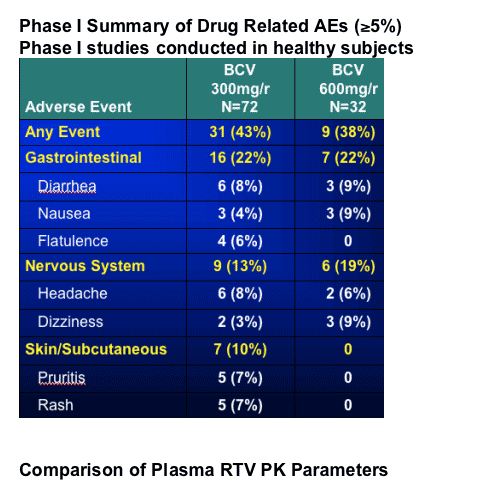
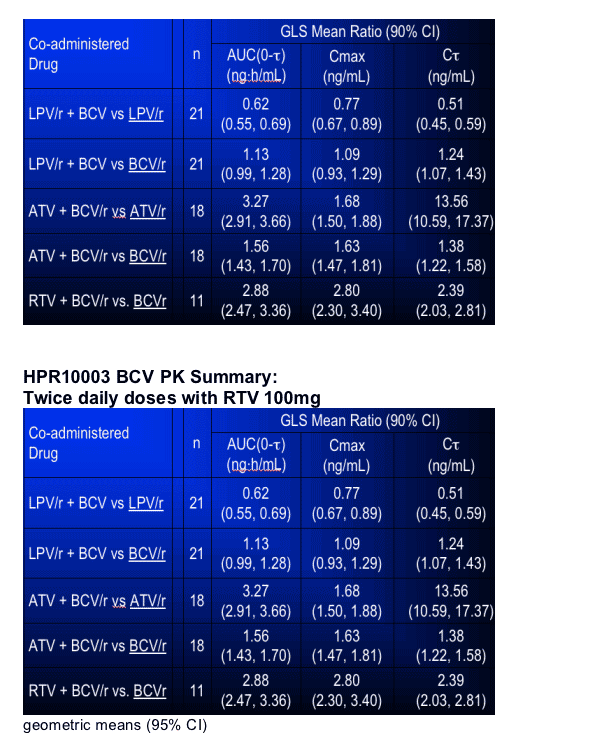
|
| |
|
 |
 |
|
|